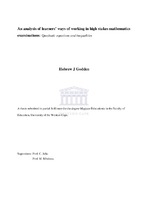| dc.description.abstract | Every year there is a national outcry by educationists in South Africa relating to the poor performance of grade 12 mathematics learners. This is an unsatisfactory state of affairs in a country where mathematics is seen as playing a pivotal role in the preparation of students in disciplines for careers in science and technology. Interventions by the Department of Basic Education as well as by provincial education departments do not seem to be successful in stemming the tide in the decline of standards in the mathematical performance of learners. It is this which has motivated this study.The aim of this study was to identify the types of errors committed by students in their responses to question one of Paper 1 in the final Grade 12 mathematics examinations of 2010. By reviewing the work done by different authors, an analytical framework was compiled that was used to identify and to label errors in the written responses of learners. This study has adopted a
documentary analysis approach and has selected a representative sample of examination scripts of Western Cape students who wrote the first paper of the grade 12 mathematics examination in 2010. The result shows that during the analysis of 1959 scripts (the sample taken from different educational departments and districts), 4163 errors were identified. These errors have been identified based on the above-mentioned analytical framework. Comparisons were labeled according to the different types of errors, across the different ex- department schools and per districts. If the percentage is calculated based on the number of scripts analyzed, the number of errors varies from 12% careless errors to 40% calculation errors. It was also noticed that the number of errors found in the urban districts was higher than all of the errors found in the different rural districts. In return, in the urban districts, the numbers of errors found were evenly distributed over the four districts. When the different ex-department schools were compared, the numbers of application and procedural errors were significantly higher in the DET schools(Department of Education and Training, which consists of mostly black disadvantaged learners) than all the other schools. The rest of the errors were evenly distributed over all the exdepartment schools. The inability of learners solving inequality equations stood out as a major concern. | en_US |

